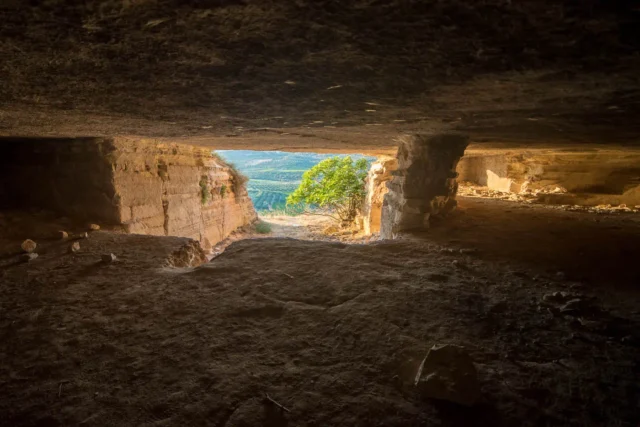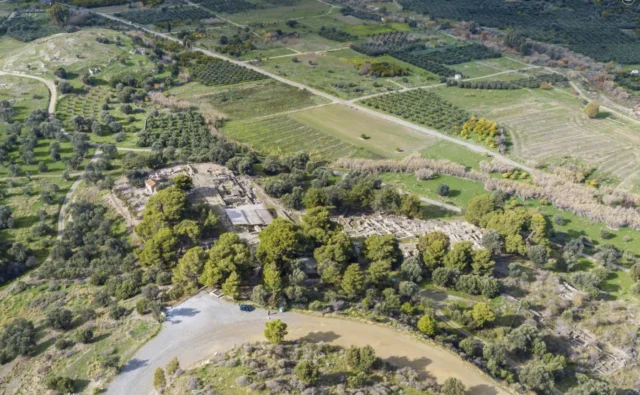107
listings found
Categories
Active filters:
Roman tombs on Gra Mantra
Agios Thomas, a Cretan mountain village, features distinctive rock-cut architecture, including Minoan wine presses and Roman tombs. The area, marked by impressive rock formations and natural caves, hosts Byzantine churches and lush greenery. Gra Mantra, a burial monument, contains numerous Roman tombs. A chapel of Kera Spiliotissa near Ardachtia displays a Greco-Roman inscription indicating a sanctuary dedicated to Larki Artemis, Demeter, and Kore. Evidence suggests a cult dedicated to chthonic deities, with local customs reflecting this. The village, part of the Gortyna Municipality, is rich in water and orchards, with a unique geological landscape.
Small Labyrinth cave
The Small Labyrinth Cave, or Labyrinthaki Cave, is an ancient 300-square-meter quarry located 50 kilometers south of Heraklion, between Plouti and Moroni, Crete. Used for stone in Minoan Phaistos, Agia Triada, and Roman Gortys, it features columns and labyrinthine passages. Distinguishing it from the larger Labyrinth Cave on the same hill, it has a depth of 120 meters and shares similar geological formations. Local tradition suggests secret passages connect the two caves, despite rockfall blockages. This site offers insights into ancient quarrying and Crete's historical architecture.
Ancient Eleutherna
The ancient city of Eleutherna in Crete, a significant center of power and culture from the Bronze Age to the Byzantine era with rich archaeological remains, including houses, public buildings, sanctuaries, and necropolises.
Gortyna archaeological site
Gortyna, located on Crete's Mesara Plain, was a major ancient city second only to Knossos. Inhabited since the Neolithic period (7000 BCE), it flourished during the Bronze Age under Minoan and Mycenaean civilizations. By the Archaic and Classical periods, Gortyna was a powerful city-state, sometimes allied with, sometimes rivaling, Knossos. In 67 BCE, Romans conquered Crete, making Gortyna capital of the province of Crete and Cyrenaica. The city thrived under Roman rule, with new infrastructure like the Praetorium, amphitheater, and Sanctuary of the Egyptian Gods.
A key discovery is the Gortyn code, the oldest known complete ancient Greek law, offering insights into 5th century BC social, economic, and legal structures. Gortyna embraced Christianity during the Byzantine era, evidenced by the Basilica of Saint Titus. The Arab conquest in the 9th century CE led to its decline. Today, Gortyna is a major archaeological site with ongoing excavations. Key sites include the Praetorium, Odeon (housing the Gortyn code inscription), amphitheater, Pythion Theater, Sanctuary of the Egyptian Gods, Basilica of Saint Titus, and Acropolis.
Festos (Phaistos)
Phaistos, a significant Minoan city in Crete, second in importance to Knossos, located in the Messara Plain. It dates back to 4000 BCE with a palace built in 1900-1700 BCE. The city was destroyed by an earthquake around 1700 BCE and rebuilt with a larger palace. Phaistos had connections with Knossos, Hagia Triada, and Gortyn. Important findings include the Phaistos Disk, Kamares Ware, and architectural remains. After a decline, Phaistos was reoccupied in the Hellenistic period (c. 323-67 BCE) until conquered by Gortyn.
Tholos Tomb of Kamilari
The Tholos Tomb of Kamilari, located on a coastal hill near Phaistos in Crete, is the largest and most well-preserved Minoan tholos tomb. Constructed around 1900 BC, it offers valuable insights into Minoan funerary practices. The tomb's proximity to Agia Triada and Phaistos suggests a connection to the elites of these settlements. The Kamilari cemetery includes three tholos tombs, with Tholos A being the most preserved, featuring a circular chamber, external rooms, and an open-air courtyard. Tholos B and C are partially preserved, with Tholos C repurposed as a shrine dedicated to Demeter and Kore. A research project is underway to study the cemetery, including its stratigraphy, artifacts, and human remains. The project aims to understand the changing mortuary behavior and social choices of the communities who used the cemetery over centuries.
Agia Triada
Agia Triada, in Crete's Messara Plain, presents a Minoan settlement with a notable Royal Villa, smaller than Knossos or Phaistos, but showcasing Minoan architecture. The site's history spans from Early Minoan to Postpalatial, with Mycenaean influence after 1450 BC. Discoveries include Linear A tablets, the Hagia Triada sarcophagus, Chieftain's Cup, and Boxer Rhyton, highlighting administrative and funerary practices. Burial sites range from tholos to chamber tombs, reflecting cultural evolution. A tripartite shrine indicates religious significance. The site's layers reveal Minoan daily life, economic functions, and interactions with the broader Mediterranean world, with artifacts exhibited in the Messara Museum.















